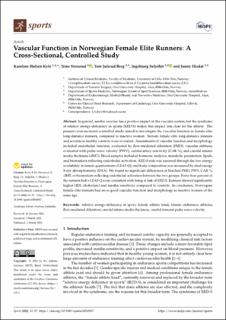Vascular function in Norwegian female elite runners: A cross-sectional, controlled study
Peer reviewed, Journal article
Published version
Permanent lenke
https://hdl.handle.net/11250/3010158Utgivelsesdato
2022Metadata
Vis full innførselSamlinger
- Artikler / Articles [2096]
- Publikasjoner fra Cristin [1084]
Sammendrag
In general, aerobic exercise has a positive impact on the vascular system, but the syndrome of relative energy-deficiency in sports (RED-S) makes this impact less clear for the athlete. The present cross-sectional controlled study aimed to investigate the vascular function in female elite long-distance runners, compared to inactive women. Sixteen female elite long-distance runners and seventeen healthy controls were recruited. Assessments of vascular function and morphology included endothelial function, evaluated by flow-mediated dilatation (FMD), vascular stiffness, evaluated with pulse wave velocity (PWV), carotid artery reactivity (CAR %), and carotid intima-media thickness (cIMT). Blood samples included hormone analyses, metabolic parameters, lipids, and biomarkers reflecting endothelial activation. RED-S risk was assessed through the low energy availability in female questionnaire (LEAF-Q), and body composition was measured by dual-energy X-ray absorptiometry (DXA). We found no significant differences in brachial FMD, PWV, CAR %, cIMT, or biomarkers reflecting endothelial activation between the two groups. Forty-four percent of the runners had a LEAF-Q score consistent with being at risk of RED-S. Runners showed significantly higher HDL-cholesterol and insulin sensitivity compared to controls. In conclusion, Norwegian female elite runners had an as good vascular function and morphology as inactive women of the same age.
Beskrivelse
This is an open access article distributed under the Creative Commons Attribution License which permits unrestricted use, distribution, and reproduction in any medium, provided the original work is properly cited.
